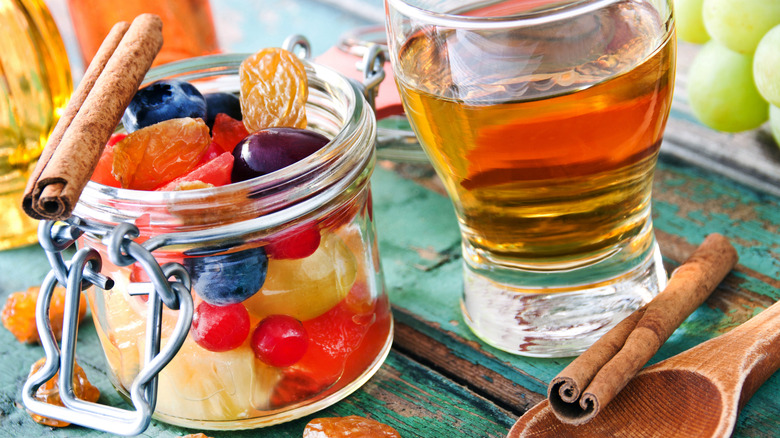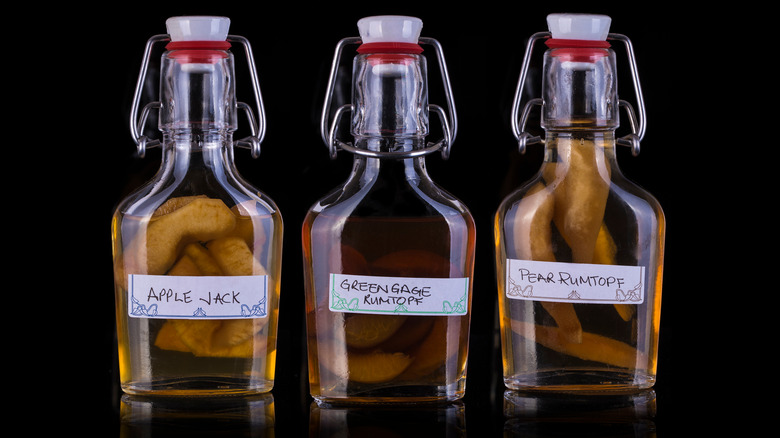Rumtopf: Germany's Boozy Fruit Preserves
From jam and jelly to curds and more, there are many ways of preserving fruit. Long utilized as a method to store a harvest, these foods have more often turned into a condiment on the grocery list. Yet there is a special fun in crafting a homemade mix — and why not throw some booze in, too? As an easy-to-make preserve, turn to rumtopf, a classic German winter treat.
Combining chopped pieces of fruit and sugar in a rum base, this beverage only necessitates a few ingredients. However, the reward is so much more. It's a versatile boozy fruit mix that can be consumed on its own, served atop desserts, and integrated into dishes. Usually stored in decorative ceramic jars, it's the perfect crowd-pleasing treat after dinner. Plus, the concoction stores for months and each batch is slightly different, depending on the combination. So how exactly did this fruity mixture come to exist, and what does it entail?
Origins of rumtopf
Rumtopf is a relatively young boozy creation since rum was only imported to Europe from the 18th century onward. In Germany, much of the sugarcane spirit entered through the northern city of Flensburg, located close to the Danish border. The port was a stop for the West Indies fleet — hence much of the spiced rum first came from the Virgin Islands.
According to legend, traders hoped to import tropical fruits from the Caribbean alongside the rum but couldn't figure out a preservation method. By chance, some fruit fell into a cask of rum before the trans-Atlantic journey. Once it arrived in Flensburg, traders sampled the creation and were enthralled by its taste — and so rumtopf was born. From here, the beverage spread throughout Germany. A sort of winter warmer, it adopted a seasonal preparation, with fruits added during the summer and the drink consumed in the winter.
Ingredients in rumtopf
Of course, a boozy base is essential for this delightful concoction. To enhance the preservative nature of the mixture, traditional recipes favor higher alcohol spiced rums, of at least 108 proof. Spiced rums distilled by Austrian producer Stroh are a popular choice. If procuring one proves difficult, it's common to mix together a high alcohol and spiced rum to achieve the ideal mixture.
When it comes to fruit addition, a large part of rumptof's allure is its malleability. Traditionally used as a method of preservation from a summer harvest, it can include a combination of whatever fruit is on hand. Common additions include strawberries, cherries, plums, peaches, and pears.
With an expansion to fruits not grown in Germany, tropical options like papaya, mango, and pineapple are also delicious options. The only fruit addition recommended to avoid is bananas — they don't mesh well with the aging process. To add an extra aromatic twist, some also add cinnamon, clove, and raisins to their batch; it wholly depends on the rendition. The final component of the mix is white sugar, which brings the entire beverage together.
How rumtopf is made
Rumtopf starts with a base created from the first harvest, and then fruits are subsequently added through the rest of the season. Fruits are cut into bite-size chunks, with any pits, seeds, stems, and rotten bits removed. They are then sprinkled with a ratio of one part sugar to two parts fruit, which can easily be adjusted if a less sweet result is desired. Next, the combination is added to a large vessel, typically about a gallon in volume. The container must also be well-sanitized to avoid any adverse reactions.
Next, the concoction is covered in the rum — with the liquor submerging all the fruit. Some eyeball the ratio, while others use a 750-milliliter bottle of rum for specifically a pound of fruit. More fruit components and spices can be added weeks or even months after the initial mixing. The rum ratio is adjusted alongside any addition. After a minimum of two months, the boozy mixture is fully matured and ready to be served.
How rumtopf is served
Interchangeable with rumtopf is the vessel it's concocted in — the rum pot itself. While a basic mason jar or another large container with a lid accomplishes the task, part of the fun is serving the beverage from a delightfully old-school ceramic jar. Much like the nostalgic cookie jars associated with Christmas in the U.S., many German families bring out their antique ceramic vessels for the beverage.
Rumtopf carries celebratory associations often brought out during social evenings with dessert. In addition to being sipped as a digestif, it's poured over ice cream, atop cake, pudding, and cheesecake. Some mix it into easy cocktails, combing it with sparking wine for a fruity spritzer.
It can also be used in cooking, whether in sweet applications like a pie crust or as a component in a lamb roast. Consider splashing some when reducing a sauce for a boozy, fruity note. However, don't let it all go towards cooking — its enchanting flavor will be a delightful sip all winter long.




